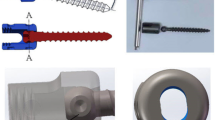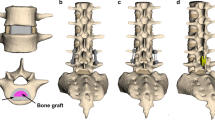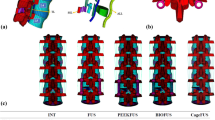Abstract
In advanced stages of degenerative disease of the lumbar spine instrumented spondylodesis is still the golden standard treatment. However, in recent years dynamic stabilisation devices are being implanted to treat the segmental instability due to iatrogenic decompression or segmental degeneration. The purpose of the present study was to investigate the stabilising effect of a classical pedicle screw/rod combination, with a moveable hinge joint connection between the screw and rod allowing one degree of freedom (cosmicMIA). Six human lumbar spines (L2–5) were loaded in a spine tester with pure moments of ±7.5 Nm in lateral bending, flexion/extension and axial rotation. The range of motion (ROM) and the neutral zone were determined for the following states: (1) intact, (2) monosegmental dynamic instrumentation (L4-5), (3) bisegmental dynamic instrumentation (L3–5), (4) bisegmental decompression (L3–5), (5) bisegmental dynamic instrumentation (L3–5) and (6) bisegmental rigid instrumentation (L3–5). Compared to the intact, with monosegmental instrumentation (2) the ROM of the treated segment was reduced to 47, 40 and 77% in lateral bending, flexion/extension and axial rotation, respectively. Bisegmental dynamic instrumentation (3) further reduced the ROM in L4-5 compared to monosegmental instrumentation to 25% (lateral bending), 28% (flexion/extension) and 57% (axial rotation). Bisegmental surgical decompression (4) caused an increase in ROM in both segments (L3–4 and L4–5) to approximately 125% and approximately 135% and 187–234% in lateral bending, flexion/extension and axial rotation, respectively. Compared to the intact state, bisegmental dynamic instrumentation after surgical decompression reduced the ROM of the two-bridged segments to 29–35% in lateral bending and 33–38% in flexion/extension. In axial rotation, the ROM was in the range of the intact specimen (87–117%). A rigid instrumentation (6) further reduced the ROM of the two-bridged segments to 20–30, 23–27 and 50–68% in lateral bending, flexion/extension and axial rotation, respectively. The results of the present study showed that compared to the intact specimen the investigated hinged dynamic stabilisation device reduced the ROM after bisegmental decompression in lateral bending and flexion/extension. Following bisegmental decompression and the thereby caused large rotational instability the device is capable of restoring the motion in axial rotation back to values in the range of the intact motion segments.




Similar content being viewed by others
References
Adams MA, Hutton WC (1981) The relevance of torsion to the mechanical derangement of the lumbar spine. Spine 6:241–248. doi:10.1097/00007632-198105000-00006
Bothmann M, Kast E, Boldt GJ, Oberle J (2008) Dynesys fixation for lumbar spine degeneration. Neurosurg Rev 31:189–196. doi:10.1007/s10143-007-0101-9
Cheng BC, Gordon J, Cheng J, Welch WC (2007) Immediate biomechanical effects of lumbar posterior dynamic stabilization above a circumferential fusion. Spine 32:2551–2557. doi:10.1097/BRS.0b013e318158cdbe
Cripton PA, Jain GM, Wittenberg RH, Nolte LP (2000) Load-sharing characteristics of stabilized lumbar spine segments. Spine 25:170–179. doi:10.1097/00007632-200001150-00006
Disch AC, Schaser KD, Melcher I, Luzzati A, Feraboli F, Schmoelz W (2008) En bloc spondylectomy reconstructions in a biomechanical in-vitro study. Eur Spine J 17:715–725. doi:10.1007/s00586-008-0588-y
Disch AC, Schmoelz W, Matziolis G, Schneider SV, Knop C, Putzier M (2008) Higher risk of adjacent segment degeneration after floating fusions: long-term outcome after low lumbar spine fusions. J Spinal Disord Tech 21:79–85. doi:10.1097/BSD.0b013e3180577259
Fuchs PD, Lindsey DP, Hsu KY, Zucherman JF, Yerby SA (2005) The use of an interspinous implant in conjunction with a graded facetectomy procedure. Spine 30:1266–1272. doi:10.1097/01.brs.0000164152.32734.d2 discussion 1273–1274
Fujiwara A, Lim TH, An HS, Tanaka N, Jeon CH, Andersson GB, Haughton VM (2000) The effect of disc degeneration and facet joint osteoarthritis on the segmental flexibility of the lumbar spine. Spine 25:3036–3044. doi:10.1097/00007632-200012010-00011
Ghiselli G, Wang JC, Bhatia NN, Hsu WK, Dawson EG (2004) Adjacent segment degeneration in the lumbar spine. J Bone Joint Surg Am 86A:1497–1503
Goel VK, Panjabi MM, Patwardhan AG, Dooris AP, Serhan H (2006) Test protocols for evaluation of spinal implants. J Bone Joint Surg Am 88(Suppl 2):103–109. doi:10.2106/JBJS.E.01363
Grob D, Benini A, Junge A, Mannion AF (2005) Clinical experience with the Dynesys semirigid fixation system for the lumbar spine: surgical and patient-oriented outcome in 50 cases after an average of 2 years. Spine 30:324–331. doi:10.1097/01.brs.0000152584.46266.25
Hilibrand AS, Robbins M (2004) Adjacent segment degeneration and adjacent segment disease: the consequences of spinal fusion? Spine J 4:190S–194S. doi:10.1016/j.spinee.2004.07.007
Kettler A, Drumm J, Heuer F, Haeussler K, Mack C, Claes L, Wilke HJ (2008) Can a modified interspinous spacer prevent instability in axial rotation and lateral bending? A biomechanical in vitro study resulting in a new idea. Clin Biomech (Bristol, Avon) 23:242–247. doi:10.1016/j.clinbiomech.2007.09.004
Khoueir P, Kim KA, Wang MY (2007) Classification of posterior dynamic stabilization devices. Neurosurg Focus 22:E3. doi:10.3171/foc.2007.22.1.3
Kim SM, Lim TJ, Paterno J, Kim DH (2004) A biomechanical comparison of supplementary posterior translaminar facet and transfacetopedicular screw fixation after anterior lumbar interbody fusion. J Neurosurg Spine 1:101–107
Knop C, Lange U, Bastian L, Blauth M (2000) Three-dimensional motion analysis with Synex. Comparative biomechanical test series with a new vertebral body replacement for the thoracolumbar spine. Eur Spine J 9:472–485. doi:10.1007/s005860000185
Meyers K, Tauber M, Sudin Y, Fleischer S, Arnin U, Girardi F, Wright T (2008) Use of instrumented pedicle screws to evaluate load sharing in posterior dynamic stabilization systems. Spine J 8:926–932. doi:10.1016/j.spinee.2007.08.008
Niosi CA, Zhu QA, Wilson DC, Keynan O, Wilson DR, Oxland TR (2006) Biomechanical characterization of the three-dimensional kinematic behaviour of the Dynesys dynamic stabilization system: an in vitro study. Eur Spine J 15:913–922. doi:10.1007/s00586-005-0948-9
Panjabi MM (1988) Biomechanical evaluation of spinal fixation devices: I. A conceptual framework. Spine 13:1129–1134
Panjabi MM, Henderson G, James Y, Timm JP (2007) StabilimaxNZ® versus simulated fusion: evaluation of adjacent-level effects. Eur Spine J 16:2159–2165. doi:10.1007/s00586-007-0444-5
Panjabi MM, Krag M, Summers D, Videman T (1985) Biomechanical time-tolerance of fresh cadaveric human spine specimens. J Orthop Res 3:292–300. doi:10.1002/jor.1100030305
Panjabi MM, Oxland TR, Yamamoto I, Crisco JJ (1994) Mechanical behavior of the human lumbar and lumbosacral spine as shown by three-dimensional load-displacement curves. J Bone Joint Surg Am 76:413–424
Phillips FM, Voronov LI, Gaitanis IN, Carandang G, Havey RM, Patwardhan AG (2006) Biomechanics of posterior dynamic stabilizing device (DIAM) after facetectomy and discectomy. Spine J 6:714–722. doi:10.1016/j.spinee.2006.02.003
Quint U, Wilke HJ, Loer F, Claes L (1998) Laminectomy and functional impairment of the lumbar spine: the importance of muscle forces in flexible and rigid instrumented stabilization—a biomechanical study in vitro. Eur Spine J 7:229–238. doi:10.1007/s005860050062
Schmoelz W, Huber JF, Nydegger T, Claes L, Wilke HJ (2003) Dynamic stabilization of the lumbar spine and its effects on adjacent segments: an in vitro experiment. J Spinal Disord Tech 16:418–423
Schulte TL, Hurschler C, Haversath M, Liljenqvist U, Bullmann V, Filler TJ, Osada N, Fallenberg EM, Hackenberg L (2008) The effect of dynamic, semi-rigid implants on the range of motion of lumbar motion segments after decompression. Eur Spine J 17:1057–1065. doi:10.1007/s00586-008-0667-0
Scifert JL, Sairyo K, Goel VK, Grobler LJ, Grosland NM, Spratt KF, Chesmel KD (1999) Stability analysis of an enhanced load sharing posterior fixation device and its equivalent conventional device in a calf spine model. Spine 24:2206–2213. doi:10.1097/00007632-199911010-00006
Stoll TM, Dubois G, Schwarzenbach O (2002) The dynamic neutralization system for the spine: a multi-center study of a novel non-fusion system. Eur Spine J 11(Suppl 2):S170–S178
Wilke HJ, Drumm J, Haussler K, Mack C, Steudel WI, Kettler A (2008) Biomechanical effect of different lumbar interspinous implants on flexibility and intradiscal pressure. Eur Spine J 17:1049–1056
Wilke HJ, Heuer F, Schmidt H (2008) Design optimization of a new posterior dynamic stabilization system. J Biomech 41(Suppl 1):S313. doi:10.1016/S0021-9290(08)70312-9
Wilke HJ, Jungkunz B, Wenger K, Claes LE (1998) Spinal segment range of motion as a function of in vitro test conditions: effects of exposure period, accumulated cycles, angular-deformation rate, and moisture condition. Anat Rec 251:15–19. doi:10.1002/(SICI)1097-0185(199805)251:1<15::AID-AR4>3.0.CO;2-D
Wilke HJ, Schmidt H, Werner K, Schmolz W, Drumm J (2006) Biomechanical evaluation of a new total posterior-element replacement system. Spine 31:2790–2796. doi:10.1097/01.brs.0000245872.45554.c0 discussion 2797
Wilke HJ, Wenger K, Claes L (1998) Testing criteria for spinal implants: recommendations for the standardization of in vitro stability testing of spinal implants. Eur Spine J 7:148–154. doi:10.1007/s005860050045
Zander T, Rohlmann A, Klockner C, Bergmann G (2003) Influence of graded facetectomy and laminectomy on spinal biomechanics. Eur Spine J 12:427–434. doi:10.1007/s00586-003-0540-0
Acknowledgment
The work was supported by corporate funds (Ulrich Medical, Ulm, Germany).
Author information
Authors and Affiliations
Corresponding author
Rights and permissions
About this article
Cite this article
Schmoelz, W., Onder, U., Martin, A. et al. Non-fusion instrumentation of the lumbar spine with a hinged pedicle screw rod system: an in vitro experiment. Eur Spine J 18, 1478–1485 (2009). https://doi.org/10.1007/s00586-009-1052-3
Received:
Revised:
Accepted:
Published:
Issue Date:
DOI: https://doi.org/10.1007/s00586-009-1052-3




